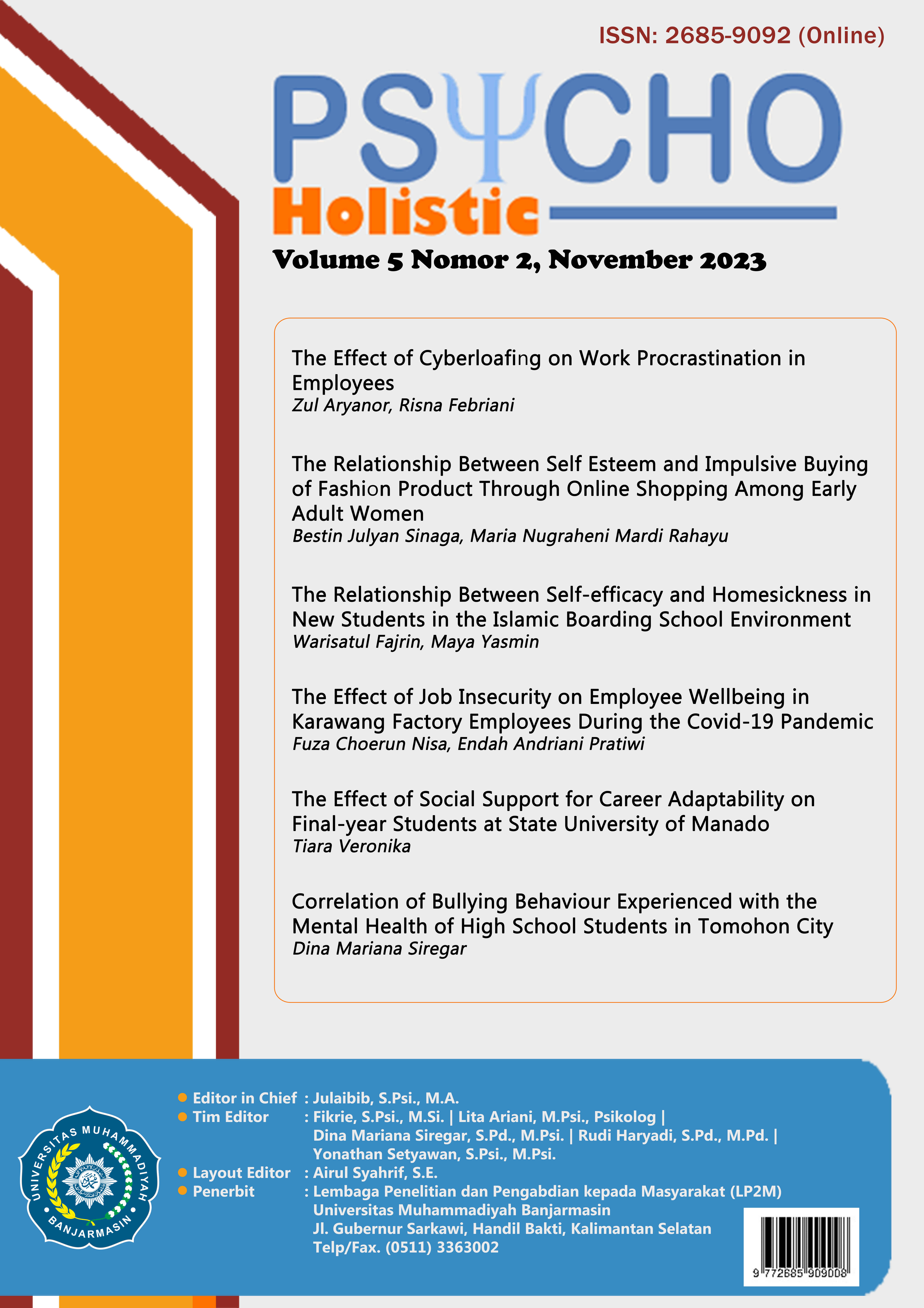The Effect of Cyberloafing on Work Procrastination in Employees
DOI:
https://doi.org/10.35747/ph.v5i2.746Keywords:
cyberloafing, employees, work procrastinationAbstract
Work procrastination is the behavior of delaying the completion of work performed by the individual (procrastinator), by performing other activities that are not related to work. One of the factors causing work procrastination is pleasure-seeking, as internet users who are always comfortable with online situations or cyberloafing. This research is located at PT. GAL and PT. GIJ. This study aims to determine the effect of cyberloafing on work procrastination in employees. This research used quantitative research methods. The sampling in this study used a non-probability sampling technique with a total sampling method of 51 employees. The scales used in this study were the cyberloafing scale and the work procrastination scale, with the Rating Scale scaling model. The results of a simple linear regression test showed that the calculated t value is 2,386 (p < 0,05) while the table t value was 2,009 which means that the calculated t value was greater than the table t, it can be collected that there was a significant influence of cyberloafing on work procrastination in employees. The results of this study indicate that cyberloafing behavior has a significant impact on employee work procrastination. This finding provides deep insights into work procrastination influenced by the tendency to seek pleasure through online activities. Therefore, it is recommended that companies consider policies that reduce employee opportunities for cyberloafing in the workplace. Additionally, enhancing training and awareness about the negative effects of cyberloafing is crucial to enabling employees to manage their internet usage productively and stay focused on their tasks without succumbing to procrastination. These suggestions are expected to improve productivity and employee performance in the workplace.
References
APJII. (2020). Laporan survei internet APJII 2019-2020. https://survei.apjii.or.id/
Askew, K. L. (2012). The relationship between cyberloafing and task performance and an examination of the theory of planned behavior as a model of cyberloafing [University of South Florida]. https://digitalcommons.usf.edu/etd/3957
Bernard, M. E. (1992). Procrastinate later: How to motivate yourself to do it now. Schwartz & Wilkinson.
Blanchard, A. L., & Henle, C. A. (2008). Correlates of different forms of cyberloafing: The role of norms and external locus of control.
Computers in Human Behavior, 24(3), 1067–1084. https://doi.org/10.1016/j.chb.2007.03.008
Diskominfo Prov. Kalteng. (2021). Kalteng kejar target merdeka signal akhir 2022. Diskominfo Prov. Kalteng. https://diskominfo.kalteng.go.id/berita/read/592/kalteng-kejar-target-merdeka-signal-akhir-2022
Dobriyal, S., & Sharma, H. (2018). Procrastination affecting the work at workplace. Journal of Emerging Technologies and Innovative Research, 5(11), 1–5. https://www.jetir.org/view?paper=JETIRDS06001
Ferrari, J. R., Johnson, J. L., & McCown, W. G. (1995). Procrastination and task avoidance: Theory, research, and treatment. Plenum Press. https://doi.org/10.1007/978-1-4899-0227-6
Filasufiah, N. E. (2022). Hubungan cyberloafing dengan prokrastinasi kerja pada pegawai Dinas Kependudukan dan Pencatatan Sipil. Psikobuletin: Buletin Ilmiah Psikologi, 3(2), 110–116. https://doi.org/10.24014/pib.v3i2.13121
Herdiati, M. F., Sujoso, A. D. P., & Hartanti, R. I. (2016). Pengaruh stresor kerja dan persepsi sanksi organisasi terhadap perilaku cyberloafing di Universitas Jember. Pustaka Kesehatan, 3(1), 179–185. https://jurnal.unej.ac.id/index.php/JPK/article/view/2522
Lavoie, J. A. A., & Pychyl, T. A. (2001). Cyberslacking and the procrastination superhighway: A web-based survey of online procrastination, attitudes, and emotion. Social Science Computer Review, 19(4), 431–444. https://doi.org/10.1177/089443930101900403
Lim, V. K. G., & Chen, D. J. Q. (2012). Cyberloafing at the workplace: Gain or drain on work? Behaviour and Information Technology, 31(4), 343–353. https://doi.org/10.1080/01449290903353054
Öǧüt, E., Şahin, M., & Demirsel, M. T. (2013). The relationship between perceived organizational justice and cyberloafing: Evidence from a public hospital in Turkey. Mediterranean Journal of Social Sciences, 4(10), 226–233. https://doi.org/10.5901/mjss.2013.v4n10p226
Oktapiansyah, H. (2018). Hubungan antara stress kerja dengan perilaku cyberloafing pada karyawan bank [Universitas Islam Indonesia]. https://dspace.uii.ac.id/handle/123456789/12369
Ozler, D. E., & Polat, G. (2012). Cyberloafing phenomenon in organizations: Determinants and impacts. International Journal of eBusiness and eGovernment Studies, 4(2), 1–15. http://www.sobiad.org/eJOURNALS/journal_IJEBEG/arhieves/2012_2/derya_ergun.pdf
Patrzek, J., Grunschel, C., & Fries, S. (2012). Academic procrastination: The perspective of university counsellors. International Journal for the Advancement of Counselling, 34(3), 185–201. https://doi.org/10.1007/s10447-012-9150-z
Paulsen, R. (2015). Non-work at work: Resistance or what? Organization, 22(3), 351–367. https://doi.org/10.1177/1350508413515541
Rahmah, A. (2018). Hubungan antara etos kerja dan cyberloafing pada aparatur sipil negara (ASN) di tingkat Provinsi Sulawesi Tengah [Universitas Islam Indonesia]. https://dspace.uii.ac.id/handle/123456789/12705
Sari, S. L., & Ratnaningsih, I. Z. (2020). Hubungan antara kontrol diri dengan intensi cyberloafing pada pegawai dinas X Provinsi Jawa Tengah. Jurnal Empati, 7(2), 572–574. https://doi.org/10.14710/empati.2018.21678
Tuckman, B. W. (1990). Measuring procrastination attitudinally and behaviorally procrastination scale. American Educational Research Association, 51, 473–480. http://files.eric.ed.gov/fulltext/ED319792.pdf
Vitak, J., Crouse, J., & Larose, R. (2011). Personal Internet use at work: Understanding cyberslacking. Computers in Human Behavior, 27(5), 1751–1759. https://doi.org/10.1016/j.chb.2011.03.002
Weatherbee, T. G. (2010). Counterproductive use of technology at work: Information & communications technologies and cyberdeviancy. Human Resource Management Review, 20(1), 35–44. https://doi.org/10.1016/j.hrmr.2009.03.012
Zatalina, N., Hidayatullah, M. S., & Yuserina, F. (2020). Hubungan cyberloafing dengan prokrastinasi kerja pada pegawai negeri sipil di kantor X Marabahan. Jurnal Kognisia, 1(2), 108–114. https://doi.org/10.20527/JK.V1I2.1555
Downloads
Published
How to Cite
Issue
Section
License
Copyright (c) 2023 Zul Aryanor, Risna Febriani

This work is licensed under a Creative Commons Attribution-ShareAlike 4.0 International License.














